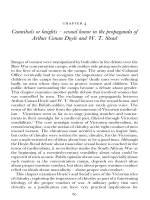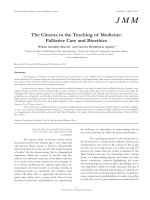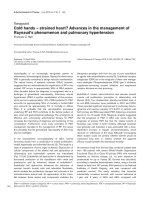Cannibals or knights – sexual honor in the propaganda of Arthur Conan Doyle and W. T. Stead
Bạn đang xem bản rút gọn của tài liệu. Xem và tải ngay bản đầy đủ của tài liệu tại đây (137.46 KB, 29 trang )
Cannibals or knights – sexual honor in the propaganda of
Arthur Conan Doyle and W. T. Stead
Images of women were manipulated by both sides in the debate over the
Boer War concentration camps, with neither side giving much attention
to the lives of actual women in the camps. The army and the Colonial
Office eventually had to recognize the importance of the women and
children in the camps because the camps’death rates were reflecting
badly on men whose duty was to protect women and children. The
public debate surrounding the camps became a debate about gender.
This chapter examines another public debate that involved women but
was controlled by men. The exchange of war propaganda between
Arthur Conan Doyle and W. T. Stead focuses on the sexual honor and
conduct of the British soldier, but women are rarely given voice. The
terms of the debate arise from the phenomenon of Victorian medieval-
ism – Victorians went so far as to stage jousting matches and tourna-
ments in their nostalgia for a medieval past, filtered through Victorian
sensibilities.¹ The core nostalgic notion of Victorian medievalism, its
central metaphor, was the notion of chivalry as the right conduct of men
toward women. The chivalrous man needed a woman to inspire him,
but codes of chivalry were written for men; chivalry, for the Victorians,
was a male-oriented set of ideas about how to be a good man. Although
the Doyle-Stead debate about masculine sexual honor is couched in the
terms of medievalism, it nevertheless marks the South African War as
the beginning of a twentieth-century sensibility about what could be
expected of men as men. Public opinion about war, and especially about
such matters as the concentration camps, depends on shared ideas
about proper wartime conduct, but ideas about proper wartime conduct
relied on ideals about masculinity – about proper male conduct.
This chapter examines Doyle’s and Stead’s uses of the Victorian idea
of chivalry, exploring the importance of chivalry as part of a functioning
ideology of the proper conduct of war. A military policy that uses
chivalry as a justification can have very practical implications for
women’s lives in wartime. Although it regulates male conduct, chivalry
as a working ideology depends on assumptions about relations between
men and women. Even in the homosocial system of war, women or the
idea of women must have an important place. In public discourse about
the concentration camps, white women were described as being vulner-
able to rape by African men, and so chivalry was called into action to
justify the Boer women’s deportation and confinement in the camps.
Similarly, in Doyle’s and Stead’s propaganda discussing the conduct of
the war and especially of the soldiers in the war, women appear
primarily as victims or potential victims of rape – but rape by British
soldiers. The Doyle-Stead debate about the sexual honor of the British
soldier was a public, wartime expression of the contested nature of
gender roles in Britain at the turn of the century. The newspaper and
pamphlet battles over the war reveal the ways that assumptions about
gender and social obligations get worked out in relation to imperial and
military concerns.
The texts on which this study relies are the productions of an anti-
war propagandist, radical journalist W. T. Stead, and a pro-war propa-
gandist, popular fiction writer Arthur Conan Doyle. Stead and Doyle
use the notion of chivalry as a key trope for the discussion of the ethics
of the conduct of the war itself, but both men eventually focus specifi-
cally on one particular type of misconduct in war – rape by soldiers.
Doyle and Stead’s debate about soldierly sexual honor reflects, among
other things, British concerns about a military force that was no longer
a professional one but that was, by mid-war, composed largely of
under-trained and unfit volunteers. What were the moral standards of
such volunteers, far from home and far from the force of British public
opinion? Was a British man in khaki a noble representative of his
nation, carrying British ideals abroad? Or was he simply ‘‘a single man
in barracks,’’ as Kipling wrote? Soldiers had always been seen as sexual
threats. But volunteer soldiers, with less of the discipline of military
training, might be an even bigger problem. Kipling’s returning volun-
teer wondered how he could ever fit in again: ‘‘me, that ’ave been what
I’ve been?’’² The soldiers were an unknown quantity, but Doyle and
Stead were participating in an effort to construct the new soldier of the
Empire within a framework that could contain and manage him, for
the people of Britain and for the returning soldiers themselves. Chival-
ry was a useful way of teaching the soldier how to behave and teaching
the British public how to think about the soldier during a war that saw
the recruitment of an entirely different kind of soldier. Before the Boer
Cannibals or knights
War, officers were gentlemen and footsoldiers were rough-and-ready
types who took the Queen’s shilling for lack of a job, to escape troubles
at home, or for adventure. With the large-scale recruiting necessary
during the Boer War, the middle and lower middle class Volunteer
corps meant that much of the fighting would now be done by non-
career soldiers who had left decent jobs at home. Public ideas about
soldiers needed revising.
Public discourse about the Boer War did not feature a strong rhetori-
cal focus on the home front. The women of Britain were in no danger
and were not especially called upon to encourage their men to join up.
To be sure, Kipling’s ‘‘The Absent-Minded Beggar’’ raised money for
the troops and their families by calling up an image of wives and
children left behind, but there was no overwhelming sense of ‘‘Women
of Britain Say, Go!’’ and no posters of bestial, ravaging Boers. Chivalry’s
place as one of the central ideologies in support of the war, and the
proper conduct of it, had to depend on women, but with the lack of
British women in the war’s rhetoric, the female place in the chivalric
ideology had to be filled by the women on the battle front – Boer
women. For the anti-war propagandist Stead, Boer women were rape
victims and potential rape victims. For Doyle, who supported the war,
Boer women were, significantly, not victims of rape; this testified to the
chivalry and purity of the British soldier. For Stead and for Doyle,
women’s place in the chivalric world of war marked either the uncon-
trollable lust of the British soldier in wartime or the self-controlled lust of
the British soldier in wartime.
In one of the last of the great British penny pamphlet controversies,
W. T. Stead’s propaganda pamphlet Methods of Barbarism and Arthur
Conan Doyle’s reply, The War in South Africa, Its Cause and Conduct, battled
for the hearts and minds of the British in the latter stages of the Boer
War. While Stead’s anti-war propaganda, in Methods of Barbarism as well
as in Shall I Slay My Brother Boer? (One response was called Shall I Kick My
Brother Stead?), and many other publications, tackles many different
themes, including the concentration camps, farm-burning, and capital-
ist inspiration for the war, Doyle’s rebuttal to Stead takes issue especially
with a single aspect of Stead’s charges – the assertion that British soldiers
raped Boer women. Doyle’s pamphlet purports to discuss the ‘‘cause
and conduct’’ of the war, but he focuses on the conduct, on questions
not of military policy but of individual behavior. Doyle links military
honor to sexual honor, just as Stead connects military misconduct with
sexual misconduct.
Gender, race, and the writing of empire
This propaganda debate, with all its class- as well as gender-based
assumptions, reveals the impact on turn-of-the-century imperialism of
ideologies honed in domestic settings. Both Stead and Doyle preached
the virtues of sexual restraint, but for Doyle restraint came from within,
from the British soldier’s sense of honor and chivalry, while for Stead
restraint had to be imposed on the soldier. For both Stead and Doyle,
sexual honor was an English issue at the same time as it was an imperial
one, and concerns about male sexual behavior in the Empire reflected
concerns about male sexual behavior at home.³ Stead’s anti-war posi-
tion is almost as influenced by ideas of chivalry drawn from Victorian
medievalism as Doyle’s pro-war position, and Stead and Doyle’s fight
about the nature of the Victorian soldier appears to have less to do with
their positions on the Boer War than with their relations to turn-of-the-
century notions of masculinity, Darwinism, and social progress.
W. T. Stead supported women’s rights. He campaigned against the
Contagious Diseases Acts and in favor of women’s suffrage. His
Pall Mall Gazette series on child prostitution in London, ‘‘The Maiden
Tribute of Modern Babylon,’’ included vivid descriptions of the sexual
debaucheries of a class of aristocratic men who preyed on the ‘‘daugh-
ters of the people.’’ These men, styled ‘‘minotaurs’’ by Stead, had so
indulged in sexual excess that for them stimulation could come only
from the rape of young virgins. Judith Walkowitz and others have
discussed the Maiden Tribute’s attitudes toward male sex drives and
Stead’s own satisfactions from playing the part of a sexual predator in
the drama he staged to ‘‘purchase’’ a thirteen-year-old girl. Upper-class
sexuality is unnatural sexuality, for Stead, because it has been corrupted
by excess. Stead’s assessments of male sexuality take a different form in
his Boer-War propaganda, however, as the sexuality of the working-
class Tommy Atkins becomes the issue, and predatory sexuality be-
comes equated not with aristocratic men but with men in a kind of
primitive, natural state.
Stead was the loudest voice in the pro-Boer movement even if the
work of Leonard Courtney and Frederic Harrison was, in the long run,
more influential (Davey The British Pro-Boers ). Because of Stead’s
public stature as a journalist, he was sure to be read, if not believed. The
Liberal leader Sir Henry Campbell-Bannerman thanked Stead for his
‘‘sound rating’’ early in the war, before Campbell-Bannerman declared
Cannibals or knights
himself a ‘‘pro-Boer.’’⁴ South African High Commissioner Alfred Mil-
ner worried when Stead came out strongly against war in South Africa
in August . Milner wrote to English South African journalist (and
former Stead prote´ge´) Edmund Garrett, ‘‘It is rather a serious matter
that Stead has taken the line he has. Of course he is not the power he
once was – still he touches a large public’’ (quoted in Davey The British
Pro-Boers ). That public shrank considerably during the Boer War, as
Stead irritated Britons by openly encouraging the Boer forces and by
castigating the British government for prosecuting the war. While other
pro-Boers more quietly lobbied for an end to the war, Stead met
publicly with Boer representatives and cheered them on to victory
(Davey The British Pro-Boers ). The first issue of his weekly publication,
War Against War in South Africa, printed a translation of the ‘‘War Hymn
of the Boers,’’ ‘‘sung by the Boers in their camps during the Majuba
campaign’’ (Majuba was the scene of the infamous Boer defeat of the
British in the first Boer War of ).⁵ This kind of slap in the face was
pushing the British public a little too far, and sales of Stead’s mainstream
organ, the Review of Reviews, began to drop dramatically as a result of his
pro-Boer activities.
Stead’s anti-war work was a huge undertaking. War Against War,
sixteen pages of newsprint, came out weekly from October
until January and included regular articles from Stead as well
as transcripts of speeches about war issues, news summaries, articles
reprinted from the dailies, poetry, and much material from foreign
newspapers. Stead wrote many pamphlets and published many more,
selling and distributing them through the Stop the War Committee
and the Review of Reviews office and offering bulk discounts for mass
distribution.
War Against War is definitively Stead’s production – he uses the first
person in its leaders and in many unsigned articles, and it was he
personally who was both attacked and credited for the views the journal
contained. On the cover of the November issue, Stead prints a
private letter to him from Olive Schreiner (‘‘Though it is a private letter,
I am sure our correspondent will forgive me for bringing it before my
readers’’). Readers of War Against War were, for Stead, ‘‘my readers.’’
Stead was seen, by himself and by observers on both sides of the war
question, as the patron saint of the anti-war movement. So the strategies
Stead would use in his propaganda to characterize the British soldier
were strategies that had to be met head-on by propagandists on the
other side of the issue.
Gender, race, and the writing of empire
One of the most important propagandists opposed to Stead was Arthur
Conan Doyle. The creator of Sherlock Holmes is not the first Victorian
writer we associate with the promotion of the aims of Empire. Rudyard
Kipling and Rider Haggard come to mind more readily, with their
tales of adventure in India and Africa. Although Doyle’s most popular
and most lasting works, the Holmes stories, often contain imperial
details, the stories are not set in the outposts of British civilization.
Holmes is a Londoner, rooted firmly in the metropolis, making occa-
sional excursions to the surrounding countryside. Nor is Doyle’s other
fiction imperial, unless we count the delightfully comic Brigadier
Etienne Gerard, who served a different Empire. Doyle’s fiction is,
however, often about war, and it is because he is concerned about war
that Doyle becomes an important public figure in support of British
imperialism at the turn of the century. Empire per se did not interest
Doyle, but war was important, with its opportunities to show British
mettle, to demonstrate the manly spirit at its best. So while Doyle
penned as important a contribution to imperial propaganda as Kip-
ling, he did so out of support for his country in wartime rather than out
of a strong commitment to the project of empire. No British literary
figure was as engaged with the fate of his country at the turn of the
century as Doyle, who spent months fighting an enteric epidemic in a
field hospital on the battle front and who would be credited with
turning much foreign public opinion around on the question of British
conduct in the war. But rather than support for the policy of imperial-
ism, it was Doyle’s conception of the link between the concepts of
personal honor and national honor that pushed him into the role of
public spokesperson for Britain.
On the occasion of the centenary of Doyle’s birth, Adrian Conan
Doyle, the author’s son, noted the senior Doyle’s frustration at being
known chiefly as the creator of Sherlock Holmes. For Adrian, ‘‘his
creation of Holmes is far overshadowed by that long list of lesser known
yet nobler accomplishments by which he served his country,’’ especially
his writings on military matters and legal and ethical concerns such as
divorce reform and the Congo atrocities (Doyle Centenary ). For serving
his country through propagandizing on its behalf during the Boer War,
Doyle earned a knighthood. But personal glory was not his object when
he undertook the task. Early in the war Doyle had tried to enlist, at the
age of forty. He explained to his horrified mother that, as he had written
Cannibals or knights
to The Times to suggest the use of mounted infantry, when the govern-
ment called for such a force, ‘‘I was honor-bound, as I had suggested it,
to volunteer. What I feel is that I have perhaps the strongest influence
over young men, especially young sporting men, of anyone in England
bar Kipling. That being so, it is really important that I should give them
a lead’’ (quoted in Carr Life of Doyle ). He was not accepted into the
military, but he was able to reach the fighting by another route. Resur-
recting his dormant qualifications as a physician – he had abandoned
his practice when he became a literary success in the early s–he
went out to South Africa as senior surgeon of a hospital for British
soldiers funded by a friend, John Langman.
From his first fame as a writer until his death, Doyle lived in the public
eye, speaking out on many issues of public controversy of the times. He
felt it was his obligation as a public figure to help defend the honor of his
country as well as to make recommendations to its leaders as to what the
best and most honorable courses of action would be. It was during the
Boer War that this newly bestselling author made his first foray into
public debate. His sense of himself as an important example for young
British men led him to volunteer for active military service during the
conflict, and his sense of his talents as a writer led him to produce a
propaganda pamphlet in defense of Britain’s conduct during the war.
He suggested, in letters to the War Office and to the newspapers,
innovations in military strategy and equipment – rifle fire that would be
able to drop into trenches rather than shooting straight over them, metal
helmets and lightweight body armor, and militia drill at home in
England to train an ever-ready defense force. (His suggestions, however,
were not enthusiastically welcomed by the War Office.) He even ran for
parliament in the Khaki Election of .
War had always interested Doyle, and he had had a brief encounter
with it in , when he happened to be in Cairo when war was
declared. ‘‘Egypt had suddenly become the storm centre of the world,
and chance had placed me there at that moment,’’ he wrote later in the
autobiographical Memories and Adventures. ‘‘Clearly I could not remain in
Cairo, but must get up by hook or by crook to the frontier’’ (–). He
was unable to reach the fighting in Egypt, but things were different a few
years later, when he met up again with many of his military acquaintan-
ces from Egypt, in the thick of the war in South Africa. Even before he
Gender, race, and the writing of empire
set off for South Africa to work in the Langman Hospital, Doyle was
planning to write a book about the war, and he started collecting
information from his fellow passengers on the voyage to Cape Town.
He published The Great Boer War while the conflict was still going on,
basing the book on notes from his experiences in South Africa, govern-
ment documents, and voluminous correspondence from soldiers, offi-
cers, and newspaper correspondents. He collected material from eye-
witnesses he met at the Langman Hospital and on his travels, and he
used his time in South Africa to gather information as efficiently as he
could, and as quickly, for he wanted his history to be the first to appear.
The book, first published in , was well received, and sixteen editions
of it were published during the war itself, each with fresh additions and
revisions. His research was extensive, much like the painstaking re-
search he had done for his historical novels. And, indeed, The Great Boer
War is reminiscent of the historical novels, with its stirring descriptions
of battles and individual acts of heroism.
As Sir Nigel Loring, in Doyle’s The White Company and the post-Boer-
War Sir Nigel, was always seeking a worthy opponent, so Doyle continu-
ously constructed the Boers in his military history as competitors worthy
of the noble British. Doyle opens The Great Boer War with a recipe:
Take a community of Dutchmen of the type of those who defended themselves
for fifty years against all the power of Spain at a time when Spain was the
greatest power in the world. Intermix with them a strain of those inflexible
French Huguenots who gave up home and fortune and left their country
forever at the time of the revocation of the Edict of Nantes. The product must
obviously be one of the most rugged, virile, unconquerable races ever seen
upon earth. Take this formidable people and train them for seven generations
in constant warfare against savage men and ferocious beasts, in circumstances
under which no weakling could survive, place them so that they acquire
exceptional skill with weapons and in horsemanship, give them a country which
is suited to the tactics of the huntsman, the marksman, and the rider. Then,
finally, put a finer temper upon their military qualities by a dour fatalistic Old
Testament religion and an ardent and consuming patriotism. Combine all
these qualities and all these impulses in one individual, and you have the
modern Boer – the most formidable antagonist who ever crossed the path of
Imperial Britain. ()
This enemy bore little relation to the stupid, backward farmer many
Britons had thought they would find in the South African republics. Of
course, a rude peasant enemy would not have allowed the British a
chance to shine – they needed a worthy opponent. In addition, how-
ever, Doyle had to account for why the war had not proceeded as
Cannibals or knights
expected. The general feeling in Britain had been in accord with the
lieutenant of the Irish Fusiliers who wrote to his parents in early October
: ‘‘I don’t think the Boers will have a chance, although I expect
there will be one or two stiff little shows here and there . . . I think they
are awful idiots to fight although we are of course very keen that they
should’’ (quoted in Pakenham Boer War ). The war was not over by
Christmas , as General Lord Roberts had predicted it would be.
Doyle’s Sir Nigel himself, with his eternal hopes for ‘‘some opportun-
ity for honorable advancement’’ through contest with any ‘‘worthy
gentleman,’’ would have been proud to do battle with The Great Boer
War’s version of Boer leader Piet Joubert. Joubert, Doyle wrote, ‘‘came
from that French Huguenot blood which has strengthened and refined
every race which it has touched, and from it he derived a chivalry and
generosity which made him respected and liked even by his opponents’’
(). The enemy were generally ‘‘brave’’ (), ‘‘gallant Boers’’ (, ),
‘‘clever and audacious’’ (). Doyle resisted the tack taken by many war
commentators who dwelt on reported Boer abuses of the white flag and
shooting of wounded. For almost every report of a Boer violation, Doyle
described a British one, excusing neither. He wanted an honorable
battle, and he found many occasions to report chivalrous or honorable
behavior by Briton and Boer. In describing the battles at Elandslaagte
and Rietfontein, Doyle reported of Sir George White that ‘‘[i]t is typical
of White’s chivalrous spirit that within ten days he refused to identify
himself with a victory when it was within his right to do so, and he took
the whole responsibility for a disaster at which he was not present’’
(–). Such selflessness was the mark of an honorable British officer; the
honorable British soldier was perhaps best represented in the following
description of an act of heroism:
The idea of an ambush could not suggest itself. Only one thing could avert an
absolute catastrophe, and that was the appearance of a hero who would accept
certain death in order to warn his comrades. Such a man rode by the wagons –
though, unhappily, in the stress and rush of the moment there is no certainty as
to his name or rank. We only know that one was found brave enough to fire his
revolver in the face of certain death. The outburst of firing which answered his
shot was the sequel which saved the column. Not often is it given a man to die so
choice a death as that of this nameless soldier. (Great Boer War )
The death of the nameless soldier was the death of the average Briton
doing his duty for his country. Such a soldier had no name in The Great
Boer War but was simply a necessary component of a narrative of
honorable combat. Tommy Atkins had an essential nobility of spirit that
Gender, race, and the writing of empire
revealed itself in moments such as these. Honor was available to all
soldiers, regardless of class, but the Tommy and the upper-class officer
earned very different sorts of honor.
After Doyle’s return to London, he remained deeply concerned about
the war. He continued to revise The Great Boer War, interviewing as many
key participants as he could and keeping up with all the details of the
war’s progress. But what disturbed him the most about the war was the
increasingly anti-British tone of the newspapers on the Continent. The
European press was printing more and more accounts of the miscon-
duct of British troops. Doyle recounted in the Cornhill after the war that:
To anyone who knew the easy going British soldier or the character of his
leaders the thing was unspeakably absurd; and yet, as I laid down the paper and
thought the matter over, I could not but admit that these Continental people
were acting under a generous and unselfish motive which was much to their
credit . . . How could they know our case? . . . Nowhere could be found a
statement which covered the whole ground in a simple fashion. Why didn’t
some Briton draw it up? And then, like a bullet through my head, came the
thought, ‘‘Why don’t you draw it up yourself?’’ (‘‘Incursion into Diplomacy’’
)
Thus began what Doyle called his ‘‘incursion into amateur diplomacy’’
(). Having already written The Great Boer War, Doyle was in a good
position to draw up a defense of Britain’s part in the war. His defense
was The War in South Africa: Its Cause and Conduct, a book-length pamphlet
which Doyle raised funds to have translated into twenty languages and
distributed for free throughout Europe, the Americas, and north Africa.
The recipients Doyle designated – the press, ministers, and professors –
were the ones J. A. Hobson would list that very year in Imperialism as the
public figures who wielded the largest influence on public opinion on
imperialism.
Chivalry came back into fashion in Victorian Britain on a wave of
revived interest in things medieval. While this Victorian medievalism
might seem to be an essentially conservative ideology, a harkening back
to less troublesome (because less democratic) times, in fact medievalism
had an appeal for social critics across the political spectrum. The
socialism of Ruskin and Morris was no less nostalgic about the days of
chivalry than the backward-looking vision that in prompted the
Earl of Eglinton to produce the rain-soaked Eglinton Tournament,
Cannibals or knights
featuring jousting and other knightly displays, at a cost upwards of
£,. By the time of the Boer War, chivalry had its satirizers, but it
was still an operative ideology, and the pro-feminist W. T. Stead was
able to make as effective use of the notion of chivalry as did the
anti-suffragist Arthur Conan Doyle.
As Mark Girouard’s lavish The Return to Camelot illustrates, the revival
of ‘‘the code of medieval chivalry, and the knights, castles, armour,
heraldry, art and literature that it produced’’ () started in Britain in
the late eighteenth century and held until World War I. Medieval castles
went up on country estates, rich men collected armor and held tourna-
ments, and, of course, the Pre-Raphaelite Brotherhood painted
Galahad, Lancelot, and Guinevere. But artists, aristocracy, and country
gentry were not alone in the craze for the courtly. Victorians were
searching for something deeper than a facade of the heroic. They
wanted an alternative to the materialist values that were accompanying
industrialization (Girouard Return ). Carlyle, in his opposition to
Mammon-worship, called for a ‘‘Chivalry of Work,’’ which would make
the aristocracy into a real governing class, would build the character of
manufacturers until they were worthy ‘‘Captains of Industry.’’ John
Stuart Mill, too, wanted heroes – but not Carlyle’s kind. In Mill
wrote of his resentment of the popular novels of the time, which ‘‘teach
nothing but (what is already too soon learnt from actual life) lessons of
worldliness, with at most the huckstering virtues which conduce to
getting on in the world.’’ Instead, Mill longed for the ‘‘old romances,
whether of chivalry or of faery,’’ which had ‘‘filled the youthful imagin-
ation with pictures of heroic men, and of what are at least as wanted,
heroic women’’ (quoted in Houghton Victorian Frame of Mind –).
The chivalrous gentleman who was the hallmark of Victorian and
Edwardian Britain had been, Girouard explains, ‘‘deliberately created’’
(Return ). In a century that saw the class struggle of Chartism, calls for
extension of voting rights and universal education, it seemed necessary
to many to recreate a medieval, aristocratic ruling class. No longer
would England be ruled on the middle-class basis of capitalism and
private property. ‘‘The aim of the chivalric tradition was to produce a
ruling class which deserved to rule because it possessed the moral
qualities necessary to rulers,’’ Girouard notes (Return ).
Although much of the revival of chivalry and its values was for-
mulated by the upper classes for the greater glory of the upper classes,
the ideology had its implications for the workers, too. A new chivalric
Britain would contain a working class bound by affection and loyalty to
Gender, race, and the writing of empire









